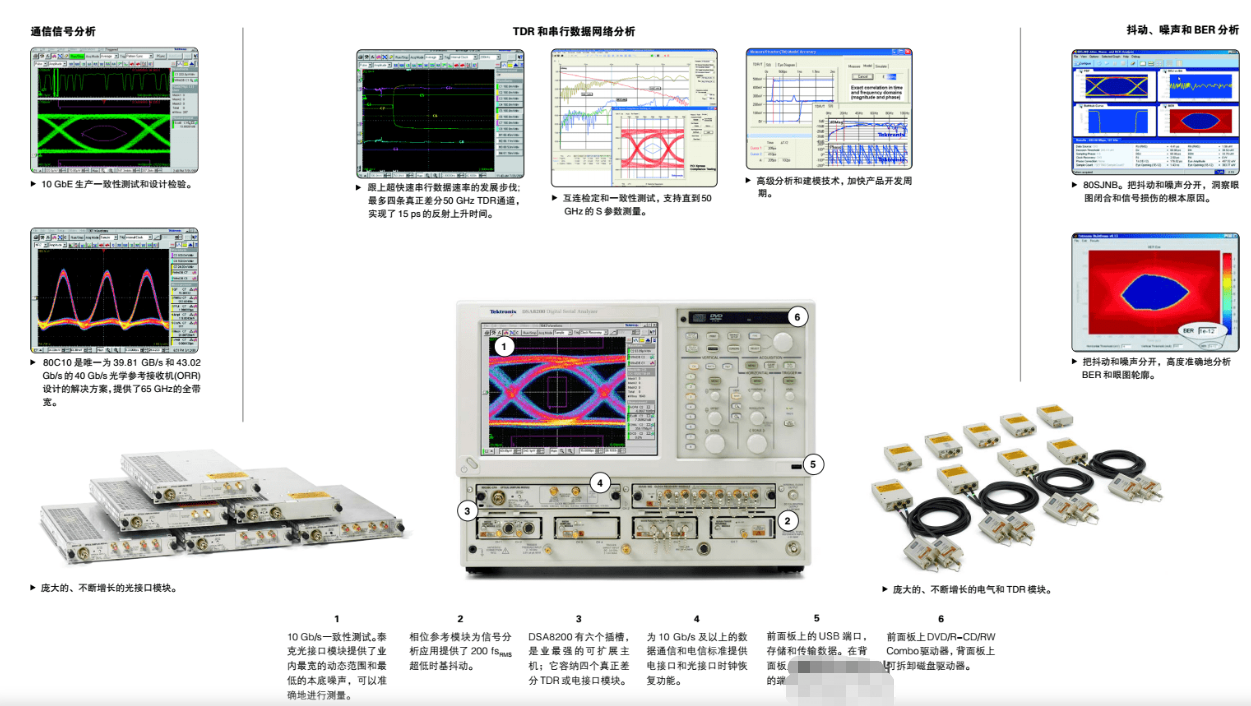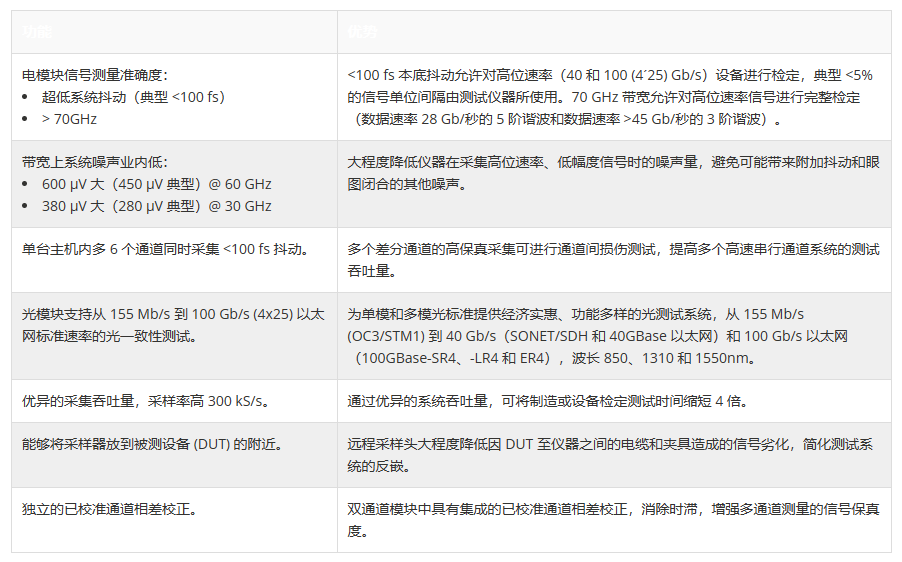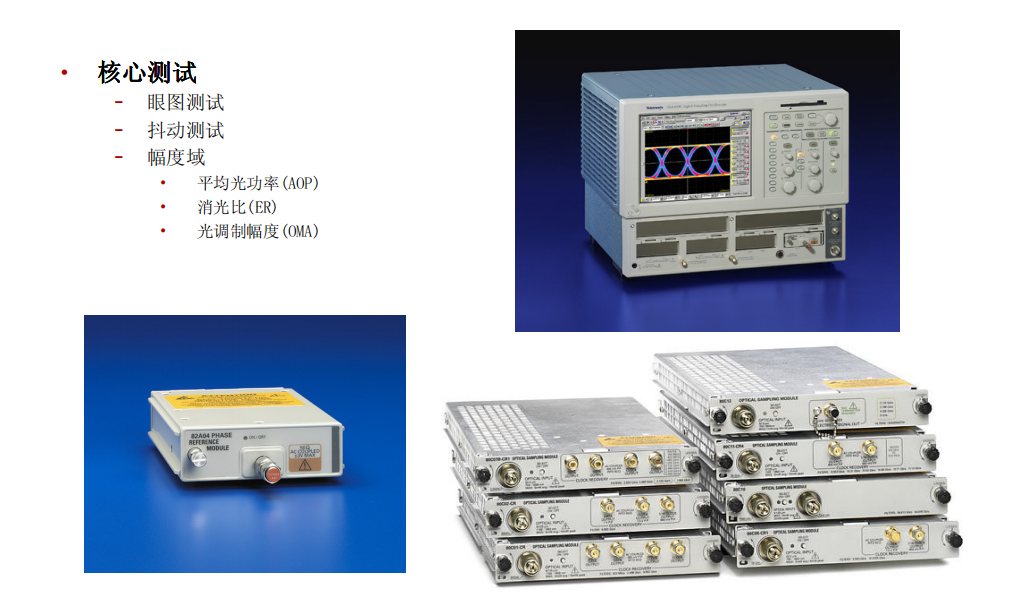Tektronix DSA8300 Digital Sampling Oscilloscopes Summary of problems, see this article
A digital sampling oscilloscope is an instrument for measuring and analysing high-speed digital signals, which can sample signals in equivalent time to achieve a sampling rate higher than the real-time bandwidth. Digital sampling oscilloscopes are available in a variety of models and brands, and different instruments have different performance and functionality for different test scenarios and needs.
Common digital sampling oscilloscopes are as follows
- DCA-X Sampling Oscilloscopes]: Equivalent time sampling oscilloscopes manufactured by Keysight that perform accurate measurements and analyses of high-speed digital designs from 50 Mb/s to 224 Gb/s. The DCA-X Sampling Oscilloscopes are available in a wide range of sizes, with fidelity and bandwidth. It features the fidelity and bandwidth, as well as a wide range of specialised application software, to perform complex test tasks such as jitter, noise, BER, SDLA and more. It also supports high-performance true differential TDR measurements for impedance calibration and network analysis of high-frequency circuits.
- [DSA8300 Digital Serial Analyser]: Equivalent Time Sampling Oscilloscope from Tektronix provides industry-leading fidelity measurement and analysis capabilities for communications signal analysis, serial data network analysis, and serial data link analysis applications. It features ultra-low time-base jitter, high vertical resolution, high bandwidth, and a wide range of optical and electrical interface modules to meet a wide range of optical data rate and electrical data rate testing needs. It also provides a variety of advanced analysis functions, such as PAM4 analysis, TDECQ analysis, SNDR analysis, TDR analysis, and S-parameter measurement.
- [PNA-X Network Analyzer]: A highly integrated and very flexible microwave test engine from Keysight for measuring amplifiers, mixers, inverters, and other active devices. Its hardware includes two internal signal sources, a signal combiner, S-parameter and noise receivers, pulse modulators and generators, and a flexible set of switches. It also offers a variety of software options, such as nonlinear vector network analysis, nonlinear pulse IV, and nonlinear differential/common-mode, for comprehensive characterisation of active devices.

Introduction to the DSA8300 Digital Sampling Oscilloscope
The DSA8300 is a state-of-the-art equivalent time sampling oscilloscope from Tektronix that measures and analyses high-speed digital signals, supporting data rates from 155 Mb/s to 100 Gb/s. The DSA8300 is designed for use in a wide variety of applications, including digital signals, digital signals, digital signals, and digital signals. It offers the following key features and benefitsh:

Introduction to the DSA8300 Digital Sampling Oscilloscope
The DSA8300 is a state-of-the-art equivalent time sampling oscilloscope from Tektronix that measures and analyses high-speed digital signals, supporting data rates from 155 Mb/s to 100 Gb/s. The DSA8300 is designed for use in a wide variety of applications, including digital signals, digital signals, digital signals, and digital signals. It offers the following key features and benefitsh:

What interface types does the DSA8300 support?
The DSA8300 supports a variety of interface types, including optical and electrical interfaces. The optical interface module can support optical data rates from 155 Mb/s to 100 Gb/s, including NRZ, RZ, PAM4 and other signal formats. Electrical interface modules can support electrical bandwidths from 20 GHz to 70 GHz, including single-ended and differential signals. Specific interface types and specifications can be found in the DSA8300 datasheet or product description.
What are the application scenarios for the DSA8300?
The DSA8300 is a digital serial analyser that can be used to test and analyse a wide range of optical and electrical interfaces for high-speed communications and data transmission. Its application scenarios include:
- Design and verification of telecom and datacom devices and systems to standards such as ITU/ANSI/IEEE/SONET/SDH.
- Manufacturing and conformance testing of optical transmitters and optical receivers, such as 100G-SR4, 400G-M4, and other specifications.
- High-performance true differential TDR measurements for detecting impedance discontinuities and S-parameters in electrical interface signal paths.
- Serial data application impedance checking and network analysis for evaluating signal integrity of interconnects and simulation model extraction.
- Advanced jitter, noise, BER and SDLA analyses for diagnosing the cause of eye diagram closures and assessing the quality of PAM4 signals.

How to use DSA8300 for measurement?
DSA8300 measurement follows the steps below:
- Select a suitable sampling module. Depending on the type and characteristics of the signals you want to measure, select an electrical interface module or an optical interface module and insert it into the module slot of the DSA8300. You can use more than one sampling module at the same time, and you can measure up to 8 signals at the same time.
- Connect the measured signals to the input ports of the sampling module and connect the reference clock signal to the clock input port of the sampling module or clock recovery module. If you are using an optical interface module, you also need to select the appropriate fibre optic connector and optical filter.
- Set the parameters of the DSA8300, including time base, trigger, vertical, horizontal, and measurement. You can use the DSA8300's touch screen or remote control interface to make the settings. You can also use the DSA8300's auto setup function to let the instrument automatically adjust the parameters according to the measured signal.
- Start the measurement and observe the waveforms and measurement results on the display of DSA8300. You can use the various analysis functions of the DSA8300, such as jitter analysis, noise analysis, BER analysis, template test, S-parameter analysis, etc., to perform in-depth evaluation and diagnosis of the signal.
A digital sampling oscilloscope is an instrument for measuring and analysing high-speed digital signals, which can sample signals in equivalent time to achieve a sampling rate higher than the real-time bandwidth. Digital sampling oscilloscopes are available in a variety of models and brands, and different instruments have different performance and functionality for different test scenarios and needs.
Common digital sampling oscilloscopes are as follows
- DCA-X Sampling Oscilloscopes]: Equivalent time sampling oscilloscopes manufactured by Keysight that perform accurate measurements and analyses of high-speed digital designs from 50 Mb/s to 224 Gb/s. The DCA-X Sampling Oscilloscopes are available in a wide range of sizes, with fidelity and bandwidth. It features the fidelity and bandwidth, as well as a wide range of specialised application software, to perform complex test tasks such as jitter, noise, BER, SDLA and more. It also supports high-performance true differential TDR measurements for impedance calibration and network analysis of high-frequency circuits.
- [DSA8300 Digital Serial Analyser]: Equivalent Time Sampling Oscilloscope from Tektronix provides industry-leading fidelity measurement and analysis capabilities for communications signal analysis, serial data network analysis, and serial data link analysis applications. It features ultra-low time-base jitter, high vertical resolution, high bandwidth, and a wide range of optical and electrical interface modules to meet a wide range of optical data rate and electrical data rate testing needs. It also provides a variety of advanced analysis functions, such as PAM4 analysis, TDECQ analysis, SNDR analysis, TDR analysis, and S-parameter measurement.
- [PNA-X Network Analyzer]: A highly integrated and very flexible microwave test engine from Keysight for measuring amplifiers, mixers, inverters, and other active devices. Its hardware includes two internal signal sources, a signal combiner, S-parameter and noise receivers, pulse modulators and generators, and a flexible set of switches. It also offers a variety of software options, such as nonlinear vector network analysis, nonlinear pulse IV, and nonlinear differential/common-mode, for comprehensive characterisation of active devices.

Introduction to the DSA8300 Digital Sampling Oscilloscope
The DSA8300 is a state-of-the-art equivalent time sampling oscilloscope from Tektronix that measures and analyses high-speed digital signals, supporting data rates from 155 Mb/s to 100 Gb/s. The DSA8300 is designed for use in a wide variety of applications, including digital signals, digital signals, digital signals, and digital signals. It offers the following key features and benefitsh:

Introduction to the DSA8300 Digital Sampling Oscilloscope
The DSA8300 is a state-of-the-art equivalent time sampling oscilloscope from Tektronix that measures and analyses high-speed digital signals, supporting data rates from 155 Mb/s to 100 Gb/s. The DSA8300 is designed for use in a wide variety of applications, including digital signals, digital signals, digital signals, and digital signals. It offers the following key features and benefitsh:

What interface types does the DSA8300 support?
The DSA8300 supports a variety of interface types, including optical and electrical interfaces. The optical interface module can support optical data rates from 155 Mb/s to 100 Gb/s, including NRZ, RZ, PAM4 and other signal formats. Electrical interface modules can support electrical bandwidths from 20 GHz to 70 GHz, including single-ended and differential signals. Specific interface types and specifications can be found in the DSA8300 datasheet or product description.
What are the application scenarios for the DSA8300?
The DSA8300 is a digital serial analyser that can be used to test and analyse a wide range of optical and electrical interfaces for high-speed communications and data transmission. Its application scenarios include:
- Design and verification of telecom and datacom devices and systems to standards such as ITU/ANSI/IEEE/SONET/SDH.
- Manufacturing and conformance testing of optical transmitters and optical receivers, such as 100G-SR4, 400G-M4, and other specifications.
- High-performance true differential TDR measurements for detecting impedance discontinuities and S-parameters in electrical interface signal paths.
- Serial data application impedance checking and network analysis for evaluating signal integrity of interconnects and simulation model extraction.
- Advanced jitter, noise, BER and SDLA analyses for diagnosing the cause of eye diagram closures and assessing the quality of PAM4 signals.

How to use DSA8300 for measurement?
DSA8300 measurement follows the steps below:
- Select a suitable sampling module. Depending on the type and characteristics of the signals you want to measure, select an electrical interface module or an optical interface module and insert it into the module slot of the DSA8300. You can use more than one sampling module at the same time, and you can measure up to 8 signals at the same time.
- Connect the measured signals to the input ports of the sampling module and connect the reference clock signal to the clock input port of the sampling module or clock recovery module. If you are using an optical interface module, you also need to select the appropriate fibre optic connector and optical filter.
- Set the parameters of the DSA8300, including time base, trigger, vertical, horizontal, and measurement. You can use the DSA8300's touch screen or remote control interface to make the settings. You can also use the DSA8300's auto setup function to let the instrument automatically adjust the parameters according to the measured signal.
- Start the measurement and observe the waveforms and measurement results on the display of DSA8300. You can use the various analysis functions of the DSA8300, such as jitter analysis, noise analysis, BER analysis, template test, S-parameter analysis, etc., to perform in-depth evaluation and diagnosis of the signal.







